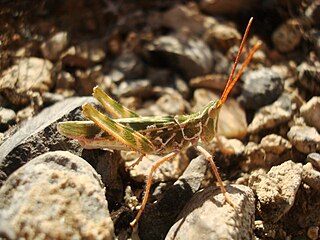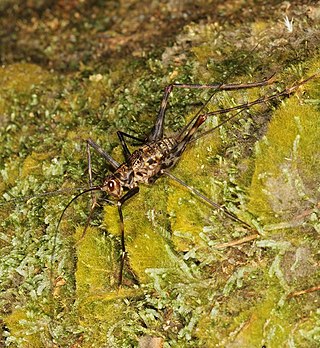
Pallas's grasshopper warbler, also known as the rusty-rumped warbler, is an Old World warbler in the grass warbler genus Helopsaltes. It breeds in the eastern Palearctic: from the Altai Mountains, Mongolia and Transbaikalia to northeastern China, the Korean Peninsula, and islands in the Sea of Okhotsk. It is migratory, wintering from India eastward to Indonesia. It is a rare migrant in Sri Lanka.

The lanceolated warbler is an Old World warbler in the grass warbler genus Locustella. It breeds from northeast European Russia across the Palearctic to northern Hokkaidō, Japan. It is migratory, wintering in Southeast Asia. The genus name Locustella is from Latin and is a diminutive of locusta, "grasshopper". This refers to the song of the common grasshopper warbler and some others in this genus. The specific lanceolata is Latin for "spear-shaped" and refers to the streaks on the breast.

The river warbler is an Old World warbler in the grass warbler genus Locustella. It breeds in eastern and central Europe, and into the western Palearctic. It is migratory, wintering in inland southern Africa, from around the Zambezi River south to the vicinity of Pretoria in South Africa. The genus name Locustella is from Latin and is a diminutive of locusta, "grasshopper". This refers to the song of the common grasshopper warbler and some others in this genus. The specific fluviatilis is Latin for "of a river".

The Japanese angelshark is a species of angelshark, family Squatinidae, found in the northwestern Pacific Ocean off China, Japan, and Korea. It is a bottom-dwelling shark found in sandy habitats down to 300 m (980 ft) deep. This species has the flattened shape with wing-like pectoral and pelvic fins typical of its family, and grows to 1.5 m (4.9 ft) or more in length. Its two dorsal fins are placed behind the pelvic fins, and a row of large thorns occurs along its dorsal midline. Its upper surface is cryptically patterned, with numerous squarish dark spots on a brown background.
Styan's grasshopper warbler, also known as Pleske's grasshopper warbler and Taczanowski's warbler, is a species of Old World warbler in the family Locustellidae. It breeds in eastern Siberia to Korea, Kyushu and Izu Islands; wintering in South China. Its natural habitats are temperate shrubland, subtropical or tropical dry shrubland, and swamps. It is threatened by habitat loss. Its name recognises the naturalist and collector, Frederick William Styan.

The grasshopper buzzard is a species of bird of prey in the family Accipitridae which is found in a narrow zone of sub-Saharan Africa north of the equator.

Acrolophitus pulchellus is a species of grasshopper in the family Acrididae. It is endemic to Idaho in the United States. Its common name is Idaho point-headed grasshopper.
Appalachia arcana is a species of grasshopper in the family Acrididae. It is known by the common names Michigan bog grasshopper and secretive locust. It is the only grasshopper that is endemic to Michigan in the United States.

The northern grasshopper mouse is a North American carnivorous rodent of the family Cricetidae. It ranges over much of the western part of the continent, from southern Saskatchewan and central Washington to Tamaulipas in northeast Mexico.

The slender burrowing grasshopper is a species of bandwing grasshopper found throughout Africa, southern Europe and southwestern Asia. It occurs in many dry open habitats with bare ground, such as savannah, grassland and Mediterranean shrubland.
The Uluguru mountain grasshopper is a rare species of grasshopper in the family Acrididae. The species is endemic to Uluguru Mountains of Tanzania, and is critically endangered due to a decline of its habitat.
The Maspalomas bow-legged grasshopper is a species of grasshopper of the family Acrididae. The species is endemic to the town of Maspalomas on Gran Canaria Island, and is considered Critically endangered, or almost extinct, since it hasn't been found since 1949.
Eupropacris abbreviata, commonly known as the Kilosa Noble Grasshopper, is a species of grasshopper of the family Acrididae. The species is endemic to Kilosa in Tanzania. It has not been seen since 1926 and it is considered critically endangered, possibly extinct, by the IUCN; the main threat is deforestation.

The Mahé boulder cricket is an insect species endemic to Mahé island in Seychelles. This species of cricket is only found in two localities, the Morne Seychellois National Park and "La Reserve". The species had not been recorded since 1909, until its rediscovery in 2014. It is a restricted range species, with an area of occupancy less than 10 square kilometres (3.9 sq mi) and with a very fragmented population.

Heteracris is a genus of short-horned grasshoppers in the family Acrididae. There are more than 60 described species in Heteracris, found in Africa, southern Europe, and manland Asia through to India.

Heteracris littoralis is a species of short-horned grasshopper in the family Acrididae. It is found in Africa, southern Europe, and Asia.











